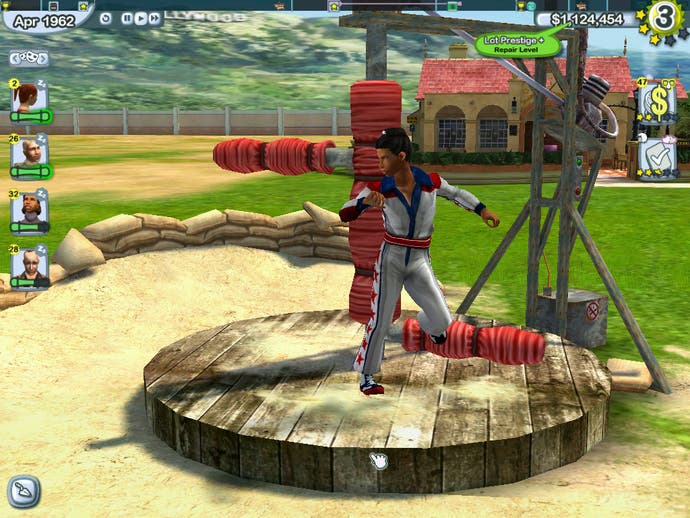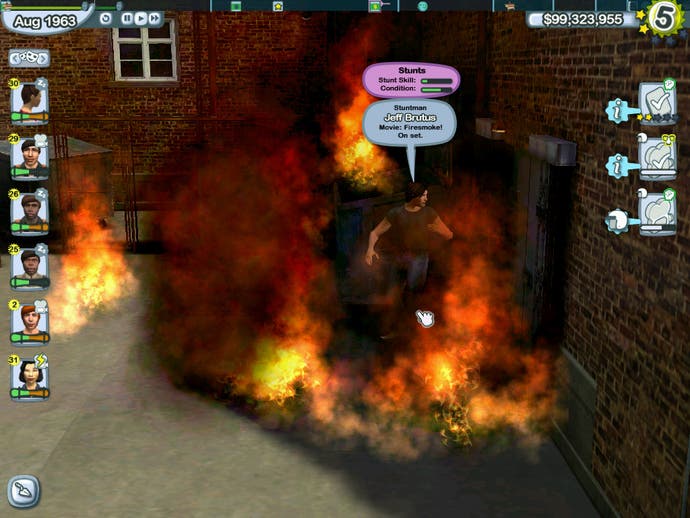The Movies: Stunts & Effects
Effectively stunted?
As a psychologist, I'm often called upon to nod and frown, whilst someone pays me lots of money so they can recline on a leather couch. Sometimes, I even get to do some psychology, which mainly consists of mentioning the word schizophrenia, tutting and frowning, like the world's axis rests on the gravitas of my words. Then I get paid lots! It's great.
So, in the case of the movies, I diagnose... schizophrenia! Or rather, multiple personality disorder (that costs double). The Movies wanted to be both a great management sim and a great movie-making program, and found that it couldn't live up to both. It wasn't bad by any means - a solid Ron Howard standard of game, rather than the hoped-for Terry Gilliam. It was just that the management side was difficult to navigate and control, while the movie-making side proved hard to get good results; you could make much better machinima with an FPS, a few friends and Microsoft movie-maker. Look upon Stunts & Effects as electro-shock therapy then. It looks spectacular, it sounds cool, and it might just heal those niggling weaknesses. Or it could drive the movies deep into mediocre madness.
Stuns & Effects does exactly what the Ronseal feller says. Starting in 1960 it adds a new class of actor, the Stuntman, as well as a selection of supporting buildings and sets, and updates some existing sets. The effect of the Effects bit is to improve how these sets look, by adding in fire, explosions and so forth. We're not going to touch on the effects bit again, so we'll just say it makes the movies look ever so slightly nicer. There are some extra-cool sets included as well, from green and blue screen stages, which allow you to replicate just about any scene, to a miniature city set.
Your stuntmen are hired in just the same way. They've got two characteristics: how healthy they are, which is called Condition, and how skilful they are at stunts, called oddly enough Stunt Skill. The latter determines what level of stunts they can do, while both combined determine how likely they are to succeed in attempting their stunt. If a stuntman fails a stunt, they'll lose health and the movie rating will drop. Moreover, if your stuntmen are a poor match for the actor they're representing, their likeness rating will drop and the audience will have less belief in the stunt. However, if they succeed, they look right and it's a novel stunt, your movie will be better watched than a certain footballer's metatarsal. Whatever the situation, the stunt appears perfectly in your finished movie, handily for you advanced movie-maker types who want to export your creation and show it off.

Of course, your normal actors can also do stunts - the audience gets a big thrill out of seeing a flaming Tom Cruise jump out of a closet and off a building into a glass of water, and only a slightly smaller thrill if he survives. As actors don't normally have a lot of stunt skill, this isn't advisable, as they will end up severely injured. Unless you really want to injure Tom Cruise.
If you do injure your stuntmen or stars, you'll have to drop them into the hospital, where they get to heal for a set period of time. Of course, you could just train them instead, so they don't injure themselves so often. Both actors and stuntmen can hop into one of three increasingly-psychotic training machines, a la Star Wars or Dune, to improve their stunt skills. Not that it makes much of a difference as the stuntmen tend to fail even the easiest stunts, no matter what their skill.
The more important updates are deeper in the expansion though. The advanced movie maker has seen a series of minor improvements and one major upgrade; a free camera. No longer do all your zombie scenes look the same; you can now have your camera located (nearly) anywhere you want in the room, facing any direction - it can even move around the room during a shot as well, panning across scenes.

The other tweaks are minor interface improvements, allowing you to save favourite scene loadouts, upgrading the weather and lighting into a larger all-encompassing environment. One neat touch is the ability to put filters over your shots, varying from security camera static to sniper scopes to greasy overlays. The makeover screen has seen several upgrades, fixing things that (again) should really have been in there from the start. These include the ability to rotate your star, a more intuitive costume picker, and the ability to alter their age and weight make-up. All very useful, none remedial.
However, the Free Cam has fixed The Movies. It's hard to emphasise how important that is. On release this was a so-so management sim with an irritatingly limited film-making mode that typically produced wooden, boring and short movies. Now it's a so-so management sim with a simple but flexible animation studio attached. Admittedly, many of the other problems haven't been fixed - staff, for example, are still in too short supply - but at least the effects add a touch of pazazz and the moviemaker mode finally works. The name may be misleading, but it was just the medicine The Movies needed.








